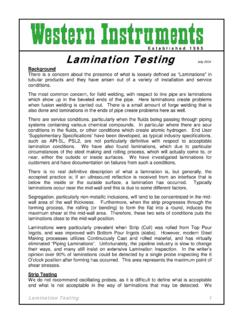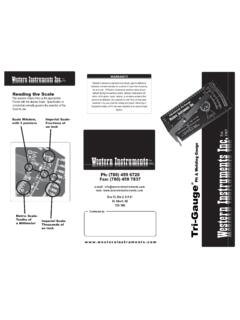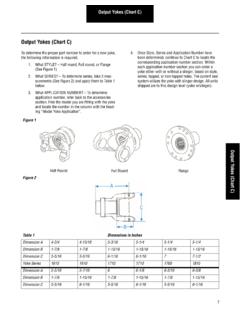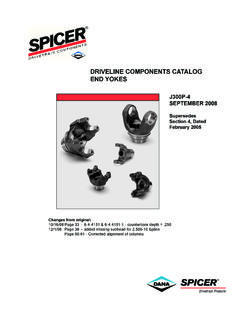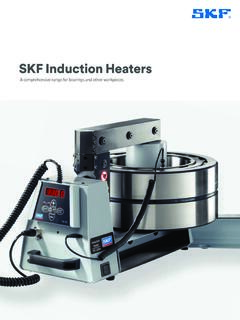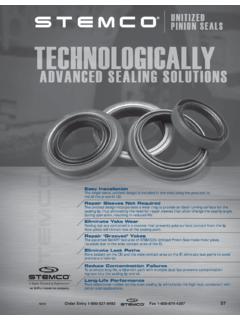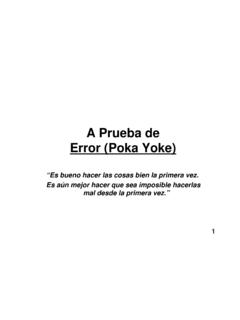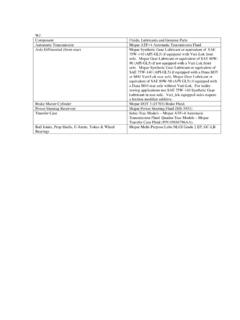Transcription of Magnetic ParticleMagnetic Particle Inspection with Yokes ...
1 Using an MPI yoke 1111 July 25, 2008 Magnetic ParticleMagnetic ParticleMagnetic ParticleMagnetic Particle Inspection with Yokes Inspection with Yokes Inspection with Yokes Inspection with Yokes The use of Yokes , as a Magnetic source, for Magnetic Particle Inspection is the most common method of MPI in the 21st century. Unfortunately most training and reference material consider the use of Wet Horizontal Benches or High Amperage Power Supplies (Cable Wraps) as the Magnetic source. This guide will help the reader in the use of MPI Yokes , as well as their selection. Magnetic FieldMagnetic FieldMagnetic FieldMagnetic Field describes the sensitive area as a circle, the same diameter as the leg spacing extending out from the centerline by the radius.
2 This may be a little over optimistic, so as a Manufacturer we will stand by the 1 or 40mm. Revealing CracksRevealing CracksRevealing CracksRevealing Cracks Normally, the Magnetic field flows along the surface of the workpiece, from one pole (+) to the other (-). However when the Magnetic field encounters an interruption, like a crack, it flows above/below and on either side of the indication, like water over a rock in a stream. Conversely, if a weld or a fastener is between the poles, the Magnetic field will also flow around it so the operator must be sure about what is actually a defect and what might just be a change in the surface of the workpiece, such as a weld undercut.
3 When these interruptions in the Field Flow occur, and the Magnetic Media is applied, it attempts to fill in the interruptions, to allow the field to move smoothly over the surface. However, the media continues to congregate at the interruption thus highlighting it very clearly. The type of Inspection media to select (Dry or Wet Method) is outlined below. Types of YokesTypes of YokesTypes of YokesTypes of Yokes There are 3 basic forms of Yokes ; AC, DC, and AC/DC. The most common type of yoke is an AC unit as it is the simplest and fastest one to use, as indications form very Established 1965 Yokes produce a Magnetic field that flows from one leg (Positive Pole) to the other (Negative Pole), thus they are sensitive to cracks that are perpendicular to the centerline of the yoke s Body.
4 Furthermore, cracks that are orientated up to45 to this centerline are also detected. As the Magnetic field flows outward and from one leg to the other, defects within about 1 (40mm), on either side of this centerline, will be detected. The picture to the right illustrates the lines of flux traveling from one Pole to the other (the pole pieces are 1 or 25mm square). The British Specification BS 6072 ( ), C L Using an MPI yoke 2222quickly. DC Yokes take several forms; Electrical (rectified AC), Battery Powered, and Permanent Magnets. Electrical or AC/DC Yokes operate from AC Power and give the operator the ability to use either an AC or a DC Field, however they require careful operation, as the controls are easily damaged.
5 AC Yokes make fast work of large areas, and require less skill to apply the Inspection media. DC Yokes give some subsurface sensitivity, however operators must be careful to apply Particle correctly, and to give time for indications to form. AC Yokes AC (Alternating Current) Yokes are so successful because the poles change from positive to negative 50 or 60 times per second, depending on the frequency of the power. This alternating field causes the Magnetic particles to vibrate on the surface of the workpiece, thus they quickly congregate at cracks. This vibration is referred to as Particle Mobility, and will be referred to further.
6 AC Yokes must lift a minimum of 10 Pounds or , which requires the Feet to be placed squarely on a Pull Test Bar (W-PT), thus permitting as much Magnetic field as possible to flow thought the bar. Thus when the yoke is place on a curved surface the operator must ensure that as much of the foot as possible is contacting the workpiece. A properly maintained AC yoke , with the feet ground flat, will lift the Pull Test Bar if the feet are at their maximum or minimum distance. DC Yokes A Direct Current (DC) Field can be produced by applying a DC voltage, such as a battery, to the internal coil of a yoke .
7 A DC field can also be produced by a Permanent Magnet, such as a fixture made with Rare Earth Magnets. Unfortunately, there is no Particle Mobility with a DC field, so the operator must introduce the particles perpendicular to the centerline between the poles. Depending on the specification being recognized, a DC yoke must lift between 40 to 50 pounds (18 to 23kg), on a pull test bar. The operator must recognize similar precautions as an AC yoke , with respect to the contact area of the feet. However, Reference Specifications limit the spacing of the feet to a maximum of 6 or 150mm, as a greater distance stops the field flow between the positive and negative poles.
8 DC Current Yokes To produce a DC Field from a 12 Volt Battery, we condition the voltage to Conserve battery power. This is done by Chopping (or interrupting) the current to the internal wire core approximately 125 times per second. Unfortunately, due Typical AC YokeHousing / Hand Grip Power Trigger Switch End Cap / Name Plate AC Power Cord /Cord Protector Contact Foot Pole Using an MPI yoke 3333to the inductance of the wire core, and the Iron Laminations of the frame, the field produced provides no greater Particle Mobility. However, the Chopping does conserve battery life and limits the lift to 50 pounds. A 12 Volt Battery can be used on an AC yoke , but it will overheat very quickly while lifting 100 pounds!
9 When a conventional AC yoke is connected to a 6 Volt Battery, it will not heat as fast and will still lift 50 pounds. Permanent Magnet These Yokes are available in two basic configurations; Hinged Frames, or Cable Type. Both perform identically, and it is really a matter of operator preference as to which on is used. Those unfamiliar with Permanent Magnet Yokes refer to the difficulty in removing or placing the contact feet to and from the workpiece, however the poles are simply moved to minimize there contact and they are easily removed. Enough can not be said about the benefits of a Permanent Magnet Yokes , but bias writers of specifications have limited their use.
10 AC/DC Yokes As their name implies, these Yokes have a selector switch that permits the operator to induce an AC Field or a DC Field. In AC Mode, the yoke is just the same as any 12 Volt Battery Pack12 Volt Power Receptacle Expandable Power CordCable Type Permanent Magnet yoke Hinge Type Permanent Magnet yoke Controls HousingAC DC Selection SwitchDC Intensity KnobTrigger SwitchUsing an MPI yoke 4444other AC yoke . When the DC Field is selected, the line voltage is reduced (in the form of heat) and rectified to produce a DC wave, often referred to as Half Wave DC, or Pulsed DC.

